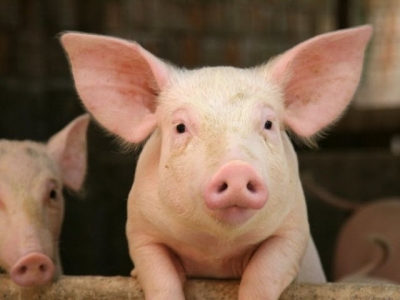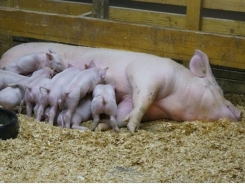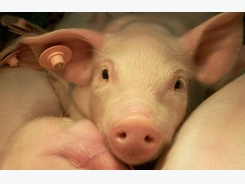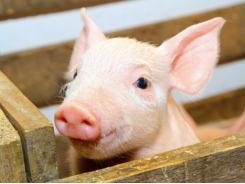Weanling pigs may see digestion bump from additive zinc oxide nanoparticles

Zinc oxide nanoparticles may offer a boost to feed, energy digestion for weanling pigs, but overall performance shows little change, say researchers.
A team of researchers from the university of São Paulo, the University of Estado de Santa Catarina and the Federal University of São Carlos examined the use of zinc oxide nanoparticles (ZnO-N) on several aspects of production for weanling pigs.
The group published its work in the journal of Animal Feed Science and Technology.
“We hypothesize that, due to it particle size properties, low dietary doses of ZnO-N are required to enhance weanling pigs’ health and growth performance compared to pharmacological doses of conventional ZnO micro particles, with reduced fecal Zn excretion,” the researchers said. “The purpose of this study was to evaluate the effects of dietary graded levels of ZnO nanoparticle (ZnO-N) on weanling pigs’ growth performance, nutrient and energy digestibility, fecal Zn excretion, diarrhea occurrence, blood parameters, organ weights, and intestinal bacteria count compared to a pharmacological dietary level of conventional ZnO.”
The team of researchers found that the different dietary levels of the nanoparticles did not alter growth performance or alter events of post-weaning diarrhea. However, the feed additive improved nutrient and energy digestion.
“Both ZnO particle size supplemented in different levels in weanling pig diets improved nutrient and energy digestibility of feed, without shown signs of animals’ toxicity,” the researchers said. But concerns about environmental release of the zinc in fecal matter continued, they added.
Why nanoparticles?
Weaning can be a time of stress followed by infection and disease for pigs, said the researchers. It has become common practice to address this by using feed additives to modulate the immune system, intestinal microbiota and seek to support animal health and performance.
Additive zinc (Zn) oxide (ZnO) at 2,000mg/kg or more has been often used to control diarrhea and boost growth, they said. Benefits linked to the practice include reduction of intestinal adhesion from pathogenic bacteria, improvements to the structure of the intestinal epithelium and to growth performance.
However, toxicity has been observed if the additive is used more than about 3 weeks-post weaning, they said. And about 80% of the ZnO is not absorbed but excreted in fecal matter.
Environmental concerns from excreted Zn and the potential for the mineral to play a role in increasing the resistance of bacteria to antibiotics have led to legislation in some areas that reduces the amount of Zn in pig diets to 150mg /kg – far below the amount traditionally used as a growth promoter, they said.
Nanoparticles of zinc oxide (ZnO-N) have been used in the chemical and pharmaceutical industries and are smaller in particle size while offering more particles per unit of mass and additional surface area when compared to traditional zinc additives, said the researchers. The smaller particles also have an easier time moving through the gut.
“Thus, ZnO-N have shown greater in vitro antibacterial activity, and absorption and permeability rate in rats compared to the ZnO microparticles normally used as growth promoter in weanling pig diets,” they said. “Such superiority is attributed to its particle size properties.”
But scientific examination of the additive in the use of animal diets is limited, they said.
Study details
In the feeding trial, 160 21-day old pigs were given one of five diets, the researchers said. Experimental diets were given from days 1 to 21 of the trial and followed on days 22-35 with a common diet.
The experimental diets included a basal diet of corn and soybean meal with 125mg ZnO/kg as a negative control, that diet with 3,000mg conventional ZnO/kg as a positive control and the basal diet with 15, 30 or 60mg ZnO-N/kg, they said.
Blood samples were collected on day 19 and selected animals were harvested on day 21 to record organ weights and intestinal bacteria count, they said. Animals were weighed on days 1, 7, 21 and 35; feed disappearance was recoded to establish average daily gain, average daily feed intake (ADFI) and the gain to feed ratio; and fecal samples were collected from days 7-12.
Results
No overall effect of dietary ZnO-N levels was found on growth performance, said the researchers. However, the gain to feed ratio and diarrhea events improved linearly on days 1-7 of the feeding trial.
“Increasing ZnO-N levels linearly increased TTAD [total tract apparent digestibility] of gross energy, dry matter, and crude protein of feed,” they said. “The pharmacological dose of ZnO improved TTAD of gross energy and crude protein of feed, and trended to improve TTAD of dry matter compared to the negative control, but did not differ from any dietary level of ZnO-N. No effects of any dietary treatments on TTAD of dietary Zn were observed.”
The change in dietary zinc nanoparticle amount did not alter fecal Zn amount, blood parameters, organ weight or intestinal bacteria count, they said. But it did increase the plasma Zn concentration as amounts were increased.
“Increasing dietary ZnO-N levels linearly increased nutrient and energy digestibility, as well as the pharmacological dose of conventional ZnO control,” said the researchers. “From 1–21 d experimental period lower ADFI was observed for ZnO-N levels and negative control compared to positive control, while no differences among treatments were observed on performance and diarrhea occurrence during the 21–35 d experimental period.”
There also were reduced fecal zinc and reduced plasma zinc levels when compared to the positive control, they said.
Related news
Tools

Phối trộn thức ăn chăn nuôi

Pha dung dịch thủy canh

Định mức cho tôm ăn

Phối trộn phân bón NPK

Xác định tỷ lệ tôm sống

Chuyển đổi đơn vị phân bón

Xác định công suất sục khí

Chuyển đổi đơn vị tôm

Tính diện tích nhà kính

Tính thể tích ao




 Nutritional research focus of new Kent swine facility
Nutritional research focus of new Kent swine facility  DDGS may support nursery pig growth, performance when…
DDGS may support nursery pig growth, performance when…